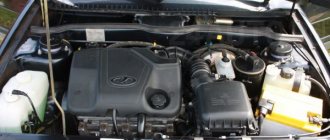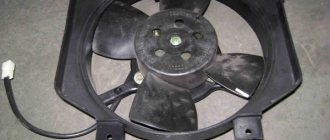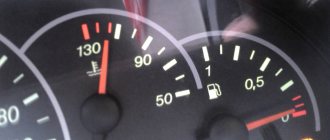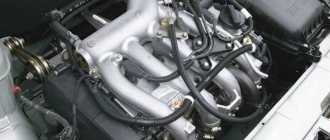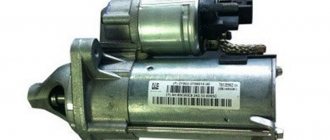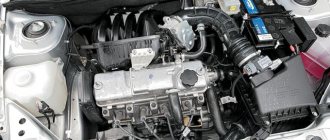On cars of the Samara 2 series, the Volzhsky Automobile Plant installed injection engines with electronic, distributed fuel injection. And for the VAZ 2114, which appeared in 2001, and was launched into series in 2003, such a power plant was developed - model 2111. In subsequent years, various modifications of this car were produced and some of them were equipped with other engine models, such as - 21114, 11183, 21124 and 21126. But the most popular production cars were the VAZ 2114 with engines of models 2111 and 11183.
The design of the injection 8-valve VAZ-2114 engine
Many motorists, especially beginners who have just purchased a VAZ-2114, have wondered how the 8-valve injection engine that is installed on this car works. This article will discuss the design of the motor, its main characteristics, as well as dismantling and repair features. This information will be very useful for beginners and those who do not know how the main power unit works.
Video about the VAZ-2114 engine
Video review of the VAZ-2114 engine operation, features and characteristics.
Lambda probe
The oxygen sensor in 2114 is an unreliable element. Its malfunction affects the stability of the engine. When the lambda probe breaks down, the engine at idle starts to work with dips. Its malfunction is first indicated by a check on the dashboard. The built-in self-diagnostic function also allows you to determine the error code. Replacing the lambda probe is done by yourself. You can continue driving if it breaks down, but this will increase consumption.
Engine diagram and structure
Before we begin to consider the issue of the engine design and description of the characteristics, it is necessary to consider the design of the components and parts that are located directly in the main power unit and outside.
Diagram and design of the Samara-2 engine
Also, it’s worth looking at a cross-section of the VAZ-2114 engine:
Cross section of the Samara engine
Characteristics of an 8-valve engine
Many motorists remember how at the end of the 90s of the 20th century and the beginning of the 2000s, the VAZ 2108-09, which was also called “Samara,” was popular on the roads of the CIS. These cars became legendary in that era. Due to the high popularity, the AvtoVAZ plant decided to resume production of these models with some modifications.
VAZ-2114 engine under the hood
Firstly, the VAZ-2114 received a modified engine . In essence, this is an injection version of the Samara. Although it received some features from modern engines. If we consider in more detail, the Samara-2 engine (this is the type installed on the VAZ-2114) is a mixture of two engine options into one: from the VAZ 2108 and VAZ 2110.
Many motorists liked the Samara-2 power unit and fell in love with it. The main indicator was ease of repair and inexpensive spare parts. Thus, the 8-valve engine has become the standard for “price-quality” indicator.
When the basic information has been reviewed, you can proceed directly to considering the characteristics of the motor.
Table of main characteristics of the Samara-2 engine 8 valves:
| Name | Characteristic |
| engine's type | In-line, longitudinal type, 4-cylinder, 8-valves |
| Fuel type | Gasoline (installation of gas equipment is possible) |
| Cylinder arrangement | 1-4-3-2 |
| Injection system | Distribution, injection type |
| Control | Bosch, "January" or GM |
| Camshaft location | Upper |
| Drive unit | Front |
| Piston and ring diameter | 82 – nominal (tolerances by group: A – 82.00-82.01, B – 82.01-82.02, C – 82.02-82.03, D – 82.03-82.04, E – 82.04-82.05) |
| Crankshaft | Cast iron |
| Cylinder block | Cast iron |
| Timing system | Belt and roller |
Disassembly and repair: basic facts
Let's consider this paragraph of the article as reference information, because if we talk about engine repair, then each individual component and unit is repaired separately. When operating the power unit, it may be necessary to dismantle it. In this case, you can consider replacing the power unit from a foreign car.
Therefore, let’s consider the main operations aimed at removing the engine from the car:
- At the preliminary disassembly stage, it is necessary to drain the oil from the engine, as well as the coolant from the system.
- Another point that should not be missed is turning off the power to the car. This is necessary in order not to short-circuit the system.
- Disconnect the fuel system.
- We dismantle the components that supply air to the engine.
- Disconnect the throttle, as well as all remaining air pipes and cooling system pipes.
- We dismantle the injection system and receiver.
- We remove the ignition system completely.
- Let's disassemble the gas distribution mechanism.
- We remove the thermostat and pump.
- Remove the ignition module.
- Now, you can dismantle the collector.
- Remove the pan, oil filter and pump.
- Disconnect the gearbox and remove the clutch. The gearbox can also be removed for convenience.
- Remove the cylinder head.
- We dismantle the power unit.
- We carry out final disassembly.
A major overhaul of the power unit will require more in-depth knowledge of the design and operating principle of the engine, but if desired, every motorist is able to understand this and carry out these operations with his own hands.
It is worth noting that when diagnosing malfunctions, it is worth carefully and carefully inspecting each part for defects.
Calculating engine cylinder volume: tips, explanations, formulas
As you know, the volume of a car engine is the sum of the volumes of all its cylinders. However, the formula for calculating the volume of a cylinder is published in various versions, which is sometimes confusing, especially for inexperienced drivers. And yet, regardless of the option used, the calculation principle in all cases remains the same. How much hot air mixture can an engine cylinder pass at one time? It’s immediately worth noting that the more, the higher the torque will be, as well as the engine power. What does “at one time” mean? A four-stroke engine completes a full cycle in 2 revolutions of the crankshaft, that is, intake, compression, power stroke and exhaust occur. So 2 revolutions or 4 measures are counted at one time.
Calculation of cylinder volume
This value is measured in cubic meters or centimeters or in liters. 1000 cm3 equals 1 liter. When specifying engine volume in liters, you must round to one decimal place. For example, if the engine capacity is 1486 cm3, then when converted to liters it should be designated as 1.5 liters; if the volume is 2526 cm3, then it should be written as 2.5 liters. The cylinder displacement of car power units is different.
The concept of cylinder displacement
The cylinder displacement is the volume between the extreme positions of the piston movement. It is filled with a combustible warm-air mixture during its intake when the piston moves from the upper extreme position to the lower one. Approaching the top dead position, the piston leaves a free volume - the combustion chamber, or compression. To calculate the full volume of the cylinder, you need to sum up the volume of the chambers and the working volume. The compression level is a value that is defined as the quotient of the total division in one cylinder and the volume of the combustion chamber. This parameter determines the degree of compression of the combustible mixture in the cylinder. The engine power depends on it, because the higher the compression level, the stronger the burning mixture presses on the piston. Increasing the compression level is beneficial, since in this case the portion of fuel can do more useful work. However, if the compression level is increased excessively, the mixture may spontaneously ignite or burn too quickly and the fuel may detonate. As a result of rapid combustion of the working mixture, the power unit operates unstably.
An increase in engine power is affected by an increase in the number of crankshaft revolutions per minute. But even here there are obstacles. This is a lack of time for the combustible mixture to enter the cylinder, the difficulty of removing exhaust gases, as well as excessive acceleration of the operation of parts and mechanisms, leading to their rapid wear. To overcome these obstacles, designers increase the number of crankshaft revolutions. For multi-cylinder power units, the cylinder volume is calculated, after which these volumes are summed up to obtain the engine displacement. An increase in engine power is a consequence of an increase in its displacement. And this parameter is determined by the class of the vehicle.
Variable displacement
Providing variable cylinder displacement is an urgent task. To achieve this effect, technology is used to automatically stop some of the cylinders when the engine is not fully loaded. This system is already used in some models of pickup trucks and SUVs, with fuel savings averaging about 20%. There are also special engines that use mechanical transformation of the piston stroke. However, they are still at the development stage. It is worth noting that internal combustion engines with variable cylinder displacement are used as laboratory equipment, allowing the octane number of gasoline to be determined “by motor method.”
Online calculator
The volume of a cylinder can be calculated using:
- base radius and height, with the height equal to the piston stroke;
- base area and height.
But there are also more complex calculators with an expanded range of functions. They allow you to calculate not only engine volume, but also the compression ratio. For calculations, the values of the following parameters are required:
- connecting rod length;
- piston stroke;
- piston under-return;
- cylinder diameter;
- piston chamber volume;
- thickness and diameter of the gasket;
- chamber volume in the cylinder head;
- number of cylinders.
Before calculating the volume of a cylinder or the entire engine, or calculating the compression level, you should clarify and record all of the above parameters. Beginners may have difficulty with this, so they will have to be persistent.
VAZ-2114 engine diagram, 8-valve injector
To independently repair a VAZ-2114 with an 8-valve injector, you need to know the structure and operating principle of the engine. With this knowledge, you can determine the cause of the malfunction without resorting to outside help. VAZ series engines are equipped with a distributed fuel injection system, which improves driving performance and typically reduces the percentage of toxins in exhaust gases. There are two types of fuel injection systems: with and without feedback, they may differ in details. Everything depends on the export or import of products. Feedback injection is usually used in car models supplied abroad and is equipped with a neutralizer. The open-loop system (sold domestically) contains a CO potentiometer that regulates the exhaust gases.
Spark plug
Spark plugs are the most important element in the system for supplying sparks to the cylinders. Plugs are responsible for producing a spark that ignites the fuel-air mixture in the cylinders. Their wear or non-compliance with factory requirements leads to the problem of improper detonation.
Useful : Engine trouble on VAZ 2114 (11 reasons)
Spark plugs are a good indicator of problems with the combustion process. Black deposits on the spark plugs mean late ignition, while white deposits indicate a lean mixture. This element of the system should be changed regularly. Poor condition of high-voltage wires or a faulty ignition coil will reduce the life of the spark plugs. Their cost for model 2114 is small, so replacement should be done every 25-30 thousand kilometers.
Sensors
The temperature sensor is a small thermostat in the cylinder head pipe; it is used to control the temperature of the antifreeze.
The knock sensor is screwed into the cylinder block and detects knocking phenomena occurring in the engine. If the slightest vibration occurs in the motor, the impulse is transmitted to it. After this, based on a signal emanating from the control unit, the ignition is adjusted, during which unwanted fuel flashes that lead to detonation are eliminated.
The oxygen level sensor is installed in a closed-loop system. Its mounting location is located in front of the muffler. The normal temperature reaches 360 degrees, and a special heating element is provided to actively warm up the motor.
The air flow sensor is mounted near the air filter. It consists of three elements, one of them determines the ambient temperature, while the rest are needed to maintain a certain temperature level exceeding that of the first. The air flow cools all heating elements, and the ECU uses this information to determine air flow and set the duration of opening or closing of the injectors.
The location of the CO potentiometer is the engine compartment (the wall of the air supply box). This element sends a signal to the computer used to adjust the desired proportion of air and fuel.
The vehicle speed sensor is located near the engine oil level dipstick. Through it, a signal is sent to the ECU similar to the speed of the drive wheels.
Synchronization sensor - located on the oil pump cover near the generator drive pulley. Based on the information coming from it, the control unit calculates the crankshaft speed and then sends a characteristic signal to the injectors.
Mass air flow sensor (MAF)
The most expensive sensor in the “four” is the mass air flow sensor. It is very sensitive to dirt and oil. Untimely replacement of the air filter and wear of the piston group lead to contamination of the mesh of the mass air flow sensor. A faulty sensor gives incorrect readings about the amount of air consumed and prevents the computer from forming the mixture normally. This increases fuel consumption. The check on the dashboard may not indicate a problem.
A malfunctioning mass air flow sensor is a serious problem. With this problem, there are failures in acceleration, engine shutdown after engaging neutral gear, and constant “floating” of revolutions. To correct the situation, you can clean the mass flow sensor housing and the mesh using chemicals. Before purchasing a new mass air flow sensor, confirm that the old one is faulty with a multimeter. The price of a new spare part is about 3 thousand rubles.
Supply system
The air filter is located in the front part of the engine and is equipped with rubber retaining elements. If it becomes necessary to replace them, the corrugation is located on the same parallel with the center line of the car. The main function of the throttle pipe is determined by dosing the air flow entering the intake pipe. The air entering the engine is adjusted thanks to the throttle valve, which is connected to the accelerator pedal. The throttle pipe consists of two components: the throttle position sensor and the idle speed control.
Air leak
A more serious and difficult to diagnose cause of increased consumption is air leaks. Damage to the corrugation to the mass air flow sensor housing, loosening of the fastenings of the pipes on the engine, damage to the manifold gasket - these are just a few sources of air leaks. There are many options for diagnosing and finding the exact location of the air leak. You can often determine the problem area by ear. In extreme cases, you can resort to using a smoke generator.
Fuel system
It consists of many components: a fuel pump, a fuel pressure regulator, a fuel filter, a fuel line, injectors and a ramp, thanks to which fuel enters the engine. The ramp is a strip on which the injectors and fuel pressure regulator are located, and is attached with two bolts to the intake pipe. The injectors are mounted on the fuel rail, its function is to supply fuel to the engine. An injector is an electromagnetic valve that opens and sprays fuel under pressure in a thin stream after it receives a corresponding impulse from the ECU. Upon contact with the heaters, the fuel evaporates and is fed through the needle pin into the combustion chamber.
Source
Throttle Position Sensor (TPS)
The TPS is responsible for determining the angle at which the damper is rotated. The power consumption, engine power, and dynamic characteristics of the car depend on this. Correct mixture formation is also impossible without correct indications from the TPS. Symptoms of its malfunction are floating speed, dips and jerks during acceleration, and the appearance of a “check” on the dashboard.
VAZ 2114 engine - possible configuration options
The 2111 engine is conventionally considered “native” for the VAZ 2114, since it has been installed for 4 years since the creation of the car model. This version of the internal combustion engine has distributed injection and 4 valves and a volume of 1.5 liters. A tuned version of 21114 with a volume of 1.6 liters was also used by increasing the height of the cylinder block.
In 2007, the engines were “pulled up” structurally to Euro-4 standards; the “four” was equipped with a 1.6 liter modification 11183 with 8 valves, an electronic gas pedal and an electric throttle, and a polymer receiver instead of aluminum.
Since 2009, the VAZ 2114 model has been modernized by its subsidiary Super-Avto CJSC. A 16-valve internal combustion engine 21124 with a volume of 1.6 liters and a power of 89 hp began to be used. With. A year later, the power unit was upgraded again; a modification of the 2126 engine of the same volume of 1.6 liters was used, but with a power of 98 hp. With.
Idle air control (IAC)
Maintaining idle speed is the main function of the IAC. The regulator periodically fails. This is reflected in the smoothness of gear shifting, maintaining warm-up speeds and gasoline consumption. The cost of the regulator is 200-300 rubles. Changes in minutes.
As you can see, there are many reasons for the increase in the “appetite” of the VAZ 2114 car. Timely diagnostics, replacement of all filter elements and a calm driving style will reduce the likelihood of breakdowns.
Characteristics of motors 2114
Since the release of the Lada Samara VAZ-2114, the technical characteristics of the gasoline drive have been constantly improved. Owners of domestic cars, in principle, do not have questions about what kind of oil to pour into the engine, since standard requirements apply for Zhiguli, Lada and Samara - 5W30 or 10W30.
In addition, you should know what kind of oil to use in transmission gears - the instructions from the AvtoVAZ manufacturer recommend using the GL-4 group of lubricants with a viscosity of 80W85 (mineral), 75W90T (synthetic) or 85W90 (semi-synthetic).
After filling with synthetics, the box becomes noisy, the oil is more expensive, but the lubricant is mostly imported, which provides additional guarantees. Domestic manufacturers most often produce semi-synthetics of average quality for engines and transmission gearboxes.
The technical characteristics of the engine are as follows:
| Characteristics | Engine modification | ||||||||
| 2111 | 21114 | 11183 | 21124 | 21126 | |||||
| Years of installation | 2003 – 2007 | 2003 – 2007 | 2007 – 2009 | 2009 – 2013 | 2009 – 2013 | ||||
| Volume | 1500 cm 3 (97.9 hp) | ||||||||
| Torque moment | 115.7 Nm (3200 rpm) | 125 Nm (3000 rpm) | 120 Nm (3200 rpm) | 131 Nm (3700 rpm) | 145 Nm (4000 rpm) | ||||
| Weight | 127.3 kg | 112 kg | 112 kg | 121 kg | 115 kg | ||||
| Compression ratio | 9,8 | 9,6 | 9,6 | 10,3 | 11 | ||||
| Nutrition | injector | ||||||||
| Engine diagram | Inline (L) | ||||||||
| Ignition | module | coil | coil | coil for each spark plug | |||||
| Number of cylinders | 4 | ||||||||
| Location of the first cylinder | TVE | ||||||||
| Number of valves on each cylinder | 2 | 2 | 2 | 4 | 4 | ||||
| Cylinder head material | aluminum alloy | ||||||||
| Intake manifold | aluminum | plastic with receiver | |||||||
| An exhaust manifold | with catalyst | ||||||||
| Camshaft | 2110 | 2111 | 2112 | ||||||
| Cylinder diameter | 82 mm | ||||||||
| Piston stroke | 71 mm | 75.6 mm | |||||||
| Pistons | Yes | No | No | Yes | No | ||||
| Valve bend | Yes | No | No | Yes | No | ||||
| Crankshaft | 2112 | 11183 | |||||||
| Fuel | AI-95 | ||||||||
| Environmental standards | Euro 4 | Euro 2 – 4 | Euro 3 – 4 | ||||||
| Fuel consumption highway/combined cycle/city | 5,7/7,3/10 | 6/7,3/10,4 | 6/7,8/11 | 5/7/9,5 | 5,4/7,2/9,8 | ||||
| Oil consumption per 1000 km | 0,7 | 0,5 | |||||||
| Engine oil for 2114 | 5W-30 and 10W-30 | ||||||||
| Engine oil volume | 4 l | 3.8 l | 3.5 l | 3.6 l | |||||
| Operating temperature | 95° | ||||||||
| Motor life | declared 150,000 km, real 250,000 km | ||||||||
| Adjustment of valves | washers between camshaft cams and tappets | hydraulic pushers | |||||||
| Cooling system | forced, antifreeze/antifreeze | ||||||||
| Coolant quantity | 7.8 l | ||||||||
| water pump | plastic impeller | ||||||||
| Candles for 2114 | A17DVRM, BPR6ES | AU17DVRM, BCPR6ES | |||||||
| Gap between spark plug electrodes | 1.1 mm | ||||||||
| Timing belt | length 698 – 1125 mm depending on attachments | ||||||||
| Cylinder operating order | 1-3-4-2 | ||||||||
| Air filter | Nitto, Knecht, Fram, WIX, Hengst | ||||||||
| Oil filter | Mann W914/2 | ||||||||
| Flywheel | 2110 | ||||||||
| Flywheel mounting bolts | M10x1.25 mm, length 26 mm | ||||||||
| Valve stem seals | code 90913-02090 inlet light code 90913-02088 exhaust dark | ||||||||
| Compression | from 14 bar | ||||||||
| XX speed | 750 – 800 | 800 – 850 | |||||||
| Tightening force of threaded connections | spark plug – 31 – 39 Nm clutch bolt – 54 – 87 Nm bearing cap – 59 Nm (main) and 43 – 53 Nm (rod) cylinder head – four stages 20 Nm, 71 Nm + 90° + 90° | ||||||||
For high-quality maintenance of internal combustion engines, the engine manufacturer issues a manual containing a description of the drive parameters, the frequency of replacing consumables and step-by-step repair operations. The same operating manual recommends the volume of oil in the gearboxes in the engine.
Pinout of mounting block 2109
The VAZ 2109 mounting block is designed to combine wiring harnesses, as well as to accommodate relays and fuses. The first models used a mounting block type 17.3722. It consists of a housing consisting of two parts and a printed circuit board on which leads are soldered for connection to the wiring harness blocks, installation of relays and fuses.
On cars with an injection engine, mounting blocks similar to 2114-3722010-60 are used, but they have a different connection for the radiator cooling fan.
| Fuse no.' | Protected Circuits |
| 1 (8 A) F9 (7.5 A) | Right fog lamp |
| 2 (8 A) F8 (7.5 A) | Left fog lamp |
| 3 (8 A) F1 (10 A) | Headlight cleaners (at the moment of switching on). Relay for turning on headlight cleaners (contacts). Headlight washer activation valve |
| 4 (16 A) F7 (30 A) | Headlight cleaners (in operating mode). Relay for turning on headlight cleaners (winding). Heater fan motor. Window washer motor. Rear window wiper motor. Rear window washer timing relay. Valves for turning on the windshield and rear windows. Relay (winding) for turning on the electric fan of the engine cooling system. Relay (coil) for turning on the heated rear window. Control 'Lamp for heated rear window. Glove compartment lamp |
| 5 (8 A) F16 (15 A) | Direction indicators and relay-interrupter for direction indicators and hazard warning lights (in turn indication mode). Turn signal indicator lamp. Rear lights (reversing lamps). Gearmotor and windshield wiper activation relay. Generator excitation winding (when starting the engine). Brake fluid level warning lamp. Oil pressure warning lamp. Carburetor air damper warning lamp. Parking brake warning lamp. Light display lamp "STOR". Coolant temperature gauge. Fuel level indicator with reserve warning lamp. Voltmeter |
| 6 (8 A) FZ (10 A) | Rear lights (brake lamps). Interior lighting |
| 6(8 A) F6 (30 A) | Power windows for front doors. Power window relay |
| 7 (8 A) F10 (7.5 A) | License plate lights. Engine compartment lamp. Instrument lighting lamps. Indicator lamp for external lighting. Heater lever illumination display. Cigarette lighter lamp |
| 8 (16 A) F5 (20 A) | The electric motor of the engine cooling system fan and its activation relay (contacts). Sound signal and relay for its activation |
| 9 (8 A) F10 (7.5 A) | Left headlight (side light). Left rear light (side light) |
| 10 (8 A) F11 (7.5 A) | Right headlight (side light). Right rear light (side light) |
| 11 (8 A) F2 (10 A) | Direction indicators and hazard warning relay-breaker (in hazard warning mode). Hazard warning lamp |
| 12 (16 A) F4 (20 A) | Rear window heating element. Relay (contacts) for turning on the heated rear window. Plug socket for portable lamp. Cigarette lighter" |
| 13 (8 A) F15 (7.5 A) | Right headlight (high beam) |
| 14 (8 A) F14 (7.5 A) | Left headlight (high beam). Indicator lamp for high beam headlights |
| 15 (8 A) F13 (7.5 A) | Left headlight (low beam) |
| 16 (8 A) F12 (7.5 A) | Right headlight (low beam) |
Engine design features
Initially, the engine of the VAZ-2114 was 8 valve, had a volume of 1.5 liters, complied with Euro-2 standards, and was marked 2111. In 2005, these engines were boosted:
- to increase the volume to 1.6 liters, the block is increased in height by 2.3 mm;
- Several configurations have been created - for Euro-2 version 21114-00, for Euro-3 model 21114-20 and for Euro-4 modification 21114-70;
- The crankshaft, valve system, camshaft correspond to 11183;
- The cylinder head received an enlarged combustion chamber of 5 x 8.1 cm, which increased power.
An important feature of the 21114 internal combustion engine is phased rather than pairwise-parallel injection, which was used in the original 2111. The attachments have become more compact:
- catalytic collector instead of the neutralizer and exhaust pipe;
- injector ramp instead of the fuel return line.
The modernization also affected other components, for example, a January 7.2 or M7.9.7 controller was used, the ignition module was replaced with a coil with 4 terminals.
At the same time, VAZ-2114 began to be equipped with engines from Kalina 11183, which have some differences from the previous version:
- the shape of the combustion chamber has been improved;
- The generator is secured with a bracket, the tensioner is modernized.
In 2008, the 2114 engine received a new M73 ECU, and in 20011, the M74 “brains” to achieve Euro-4 standards. The control became completely electronic, but for another whole year the designers corrected firmware defects until they created its final version I414DE07.
The next engine, 2114, was installed on the car by a subsidiary of the manufacturer AvtoVAZ, called Super-Auto, in 2009. It was the 16 valve engine 21124 of the “tenth” VAZ family with improved characteristics:
- “high” blue block (197.1 mm);
- injectors pressed into 2–5 main bearing supports, cooling the pistons with oil;
- The groove depth of the holes in the valves is 5.53 mm, which ensures the safety of the valves in the event of a timing belt break; major repairs are not required.
The following year, the fourteenth models began to be equipped with 21126 engines from export Priors. After tuning the 21124 engine, the internal combustion engine device differs in the following nuances:
- honed cylinders, gray block;
- crankshaft pulley and timing belt with semicircular tooth;
- the weight of the connecting rod and piston group is reduced;
- there is no friction in the lower head of the connecting rod;
- candle glasses are built into the head.
The internal combustion engine uses the principle of hydraulic compensation of valve clearances; the 0.45 mm thick cylinder head gasket is made of multilayer metal. The motor is equipped for Euro-3 with a collector 11194-1203008-10 or Euro-4 with a collector 11194-1203008-00. The service life of the pump has been increased due to a new design of the oil seal and bearing, and changes to the toothed pulley.
The ignition system has a separate coil for each spark plug. Phased injection, stainless steel fuel rail, January 7.2 or M7.9.7 controllers.
Place in the lineup
The VAZ 2115 replaced the five-door sedan 21099 with the characteristic angular lines of the first generation of front-wheel drive cars from Togliatti. The lines of the tag became softer, the car acquired new front body panels, smaller headlights, and an updated radiator grille. The middle part of the body, doors and roof were inherited from model 21099. The rear part of the body was updated - the loading height of the luggage compartment was significantly reduced, the trunk lid was decorated with a fashionable rear wing (spoiler with a duplicate brake light).
Bumpers began to be painted in body color. This has increased the visual appeal, but many car owners complain about the fragility of the new bumpers. Experts evaluate the pros and cons of the VAZ 2115 differently: some consider the new bumpers a plus, others consider them a minus. The exterior of the car has become less angular, although it has somewhat lost its individuality. Sometimes, to restore the brutality of a car, a low landing of the 2115 model is used.
A new European instrument panel has appeared in the cabin. The steering column has become adjustable, which has improved the ergonomics of the driver's workplace. The interior heating system has been significantly improved. In winter, the car became noticeably warmer than in its predecessor.
Cons and pros
Depending on which 2114 engine is used, the owner’s risks differ:
- 2111, 21183, 21114 and 21124 – do not bend the valve if the timing belt breaks;
- 21126 – valve bending due to insufficient groove.
The main disadvantage of the latest 16 valve versions is the lighter crank mechanism:
- the engine is adjusted to Euro-4 standards;
- to reduce weight, the length of the piston skirt is reduced;
- Accordingly, the width of the oil scraper and compression rings decreases;
- The resource of the internal combustion engine is sharply reduced.
For example, in Japan, manufacturers abandoned Euro-4 standards, considering that the reliability and high service life of the motor are more important for the consumer.
The drive power increased from 77 horsepower to 81 hp, then 82 hp, 89 hp, and 98 hp. In models with hydraulic compensators, periodic adjustment of this unit is not required, however, the quality of the oil in the system must be high for normal operation of the pushers.
Ignition module
The appearance of microcracks in the ignition module housing is a common occurrence. Poor quality plastic, which shrinks under the influence of temperatures, leads to the appearance of cracks. Insufficient spark power reaching the wires, and then to the spark plugs, leads to the problem of improper ignition of the mixture. In case of such a malfunction, the check also lights up.
You should not try to glue microcracks, because... they will appear again when exposed to temperature. Replace the ignition module and reset the errors. If there are breakdowns, check the condition of the wiring to the module and the condition of the chip.
A malfunction of the module not only causes high gas consumption, but also leads to “tweaking” of the engine, which can lead to rapid wear. Malfunctions in the spark supply system conceal a lot of problems: decreased dynamics, the appearance of lumbago, contamination of the combustion chamber of the mixture due to the lack of a spark, etc.
Maintenance schedule
To avoid having to carry out expensive overhauls of the Lada Samara 2114 yourself, you should follow the manufacturer’s recommendations for servicing the internal combustion engine:
| Maintenance object | Time or mileage (whichever comes first) |
| Timing belt | replacement after 100,000 km |
| Battery | 1 year/20000 |
| Valve clearance | 2 years/20000 |
| Crankcase ventilation | 2 years/20000 |
| Belts that drive attachments | 2 years/20000 |
| Fuel line and tank cap | 2 years/40000 |
| Motor oil | 1 year/10000 |
| Oil filter | 1 year/10000 |
| Air filter | 1 – 2 years/40000 |
| Fuel filter | 4 years/40000 |
| Heating/Cooling Fittings and Hoses | 2 years/40000 |
| Coolant | 2 years/40000 |
| Oxygen sensor | 100000 |
| Spark plug | 1 – 2 years/20000 |
| Exhaust manifold | 1 year |
If consumables are replaced within the recommended time frame, the operational life of the internal combustion engine will increase.
Should high-voltage wires be replaced and when?
No matter how well the armored wires are made, they also have a limited service life. According to current regulations, they must be replaced after every 30,000 km traveled. In practice, many motorists ignore this rule, continuing to travel with wires that have already outlived their useful life.
Such inattention can cause a whole host of problems, including:
- poor ignition;
- overclocking problems;
- engine tripping;
- inability to start the car.
All these troubles are caused by one single factor - an increase in the electrical resistance of the core of high-voltage wires, as a result of which it becomes “more difficult” for the impulse from the coil to reach its destination.
You can check whether you can still drive with the old wires or not - at home.
To do this you need:
- Turn off the ignition.
- Remove one of the armored wires.
- Measure its resistance using a megohmmeter or multimeter in the appropriate mode.
- If the resistance turns out to be equal to or close to the figure indicated on the wire insulation, then it is in good condition, but if it turns out to be greater, then the wire should be replaced.
- Repeat this operation on the remaining three wires.
It should be remembered that if only one of the wires is faulty, then all four should still be replaced.
Also, do not forget about the cleanliness of the contacts of high-voltage wires - they can also cause ignition problems. If oxides are noticeable on the metal tip, they should be cleaned with fine sandpaper or a cloth moistened with kerosene. By following these simple rules for caring for armored wires and replacing them, you can almost completely avoid troubles associated with the ignition system.
Typical breakdowns
The very first 1.5 liter engine 2114 has disadvantages:
- periodic valve adjustment;
- unreliable injection system;
- loosening the exhaust manifold nuts;
- Leaking gaskets of the fuel pump, distribution sensor of the ignition system.
The next 1.6 liter engine does not cause any particular problems for the owner, with the exception of high vibration and noise loads. The weak point traditionally remains the valves, which have to be constantly adjusted.
The internal combustion engine from Lada Kalina 11183 was installed on the fourteenth model solely to meet Euro-3 standards. It has typical disadvantages for a linear series and is no different.
The first sixteen-valve engine 21124 does not bend the valves, the gaps in which are adjusted by hydraulic pushers. However, the belt needs to be tightened after 15,000 km due to the large number of attachments. The second and last in the line of fourteenth ICE models, ICE 21126, has increased power. In addition to typical malfunctions, if the timing belt breaks, the piston will bend the valve due to insufficient recess depth.
Low compression in the engine
Gradual wear of the piston group and the engine as a whole is inevitable even with constant maintenance. Insufficient compression in the cylinders is a sign of wear. In such a situation, the engine stops producing maximum power, which increases fuel costs. In addition, oil consumption in the engine appears. Repairing the piston group is a logical option to solve the problem. To begin with, you can decarbonize the rings and fill in the additive. This will have a small effect, but will still reduce the level of gasoline consumed.
In the photo, the engine compression indicator is 13 points, which is a good indicator.
Improved dynamic performance
To improve the dynamic characteristics of the VAZ 2114 engine on a budget, you can do the following:
- modify the intake and exhaust, namely install a larger throttle valve, an intake receiver and an exhaust without a 4-2-1 catalyst, popularly called a “spider”;
- split gear for phase adjustment;
- non-standard camshafts;
- if you have an 8-valve engine, the best solution would be to replace the cylinder head with a 16-valve one;
- modification of the cylinder head of varying complexity can increase the maximum power to 120 hp. With. without loss of resource.
Tuning can go as far as installing turbocharging, nitrous oxide injection and other means that significantly increase power, but all of them are quite expensive and reduce engine life.
When modifying, do not forget that all procedures must be supplemented with appropriate software for the control unit, otherwise your tuning may adversely affect the operation of the motor.
Optimal tuning kit
Chip tuning of the VAZ-2114 allows you to change the factory settings of the electronics. In this way, you can change the ignition timing, the operation of the injection system and other little things. The increase in “horses” will be about 10%, while the car can work much better in a more convenient mode for the driver. The electronic circuit will not experience stress when changing parameters, so this method is also considered safe for the machine.
What kind of tuning of the VAZ-2114 engine should be carried out?
- If you want to improve its driving characteristics without causing much harm to your car, the best choice is reprogramming, or so-called chip tuning. The control of the VAZ engine of the fourteenth model is mainly dependent on the interaction of electronics - sensors and ECUs. By changing some settings to suit yourself, you can achieve a reduction in fuel costs, more streamlined engine operation at start and load, and optimal fuel supply through the injector. To do this, you will need a programmer that will allow you to repeatedly change the computer settings.
- The second type of tuning will be the cooling system. Overheating is a problem that literally all VAZs of any generation have. So it's worth thinking about several innovations in the cooling system. One solution recommended here is to direct the coolant directly to the thermostat from the heater. To do this, a new pipe is soldered into the cooling system, and the pump hole is turned off. The work requires good knowledge of the machine, so it is not recommended for beginners. When upgrading the pipe, the engine temperature sensor will show several degrees lower than usual, and the operation of the car in summer will become more stable.
- The VAZ-2114 engine mounts are part of the vehicle's support system. Thanks to these parts, the driver does not feel vibrations in the cabin. If you are going to add parts that will increase the weight of the engine assembly, take care to strengthen the supports.
Asynchronous motor power
In the technical field of science, there are three types of power:
- full (denoted by the letter S);
- active (denoted by the letter P);
- reactive (denoted by the letter Q).
The total power can be represented as a vector that has a real and an imaginary part (it is worth recalling the section of mathematics associated with complex numbers).
The real part represents the active power, which is expended to perform useful work such as rotating a shaft, as well as to generate heat.
The imaginary part is expressed by reactive power, which takes part in the creation of magnetic flux (denoted by the letter F).
It is the magnetic flux that underlies the operating principle of an asynchronous unit, a synchronous motor, a DC machine, and a transformer.
Reactive power is used to charge capacitors, creating a magnetic field around the chokes.
Active power is calculated as the product of current with voltage and power factor:
P = I * U * cosφ.
Reactive power is calculated as the product of current with voltage and power factor, phase shifted by 90°. Otherwise you can write:
Q = I * U * sinφ.
The value of the total power, if we remember that it can be represented as a vector, can be calculated using the Pythagorean theorem as the root of the sum of the squares of active and reactive power:
S = (P2+Q2)1/2.
If we calculate the formula for total power in general form, it turns out that S is the product of current and voltage:
S = I * U.
Power factor cosφ is a value numerically equal to the ratio of the active component to the total power. To find sinφ, knowing cosφ, you need to calculate the value of φ in degrees and find its sine.
This is a standard calculation of motor power by current and voltage.

